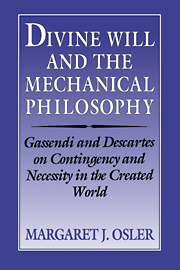 Divine Will and the Mechanical Philosophy
Divine Will and the Mechanical Philosophy Book contents
- Frontmatter
- Contents
- Acknowledgments
- Introduction
- Part I Theology and the philosophy of nature
- Part II The mechanical philosophy and the formation of scientific styles
- 7 Introduction: Theories of matter and their epistemological roots
- 8 Gassendi's atomism: An empirical theory of matter
- 9 Mathematizing nature: Descartes' geometrical theory of matter
- 10 Conclusion: Theology transformed – the emergence of styles of science
- Bibliography
- Index
9 - Mathematizing nature: Descartes' geometrical theory of matter
Published online by Cambridge University Press: 11 September 2009
- Frontmatter
- Contents
- Acknowledgments
- Introduction
- Part I Theology and the philosophy of nature
- Part II The mechanical philosophy and the formation of scientific styles
- 7 Introduction: Theories of matter and their epistemological roots
- 8 Gassendi's atomism: An empirical theory of matter
- 9 Mathematizing nature: Descartes' geometrical theory of matter
- 10 Conclusion: Theology transformed – the emergence of styles of science
- Bibliography
- Index
Summary
I neither admit nor desire any principles in physics other than [those] in geometry or abstract mathematics; because all the phenomena of nature are thus explained, and certain demonstrations concerning them can be given.
René Descartes, Principia philosophiaeLike many other seventeenth-century natural philosophers, Descartes shared with Gassendi the goal of replacing Aristotelianism with a mechanical philosophy of nature. Descartes presumed that there was a close relationship between the metaphysical roots of this philosophy – which he worked out in the Meditations and Part I of The Principles of Philosophy – and the mechanical explanations that grew from those roots. Articulating what he considered the conceptual framework within which natural philosophy was to develop, Descartes specified what sorts of things exist in the world and the means by which they interact. Accordingly, he described a new theory of matter and redefined causality, replacing the old scheme root and branch.
From the time Descartes began composing Le monde in 1629 until the end of his life, he consistently held certain consistent views about natural philosophy. The physical world, he thought, consists entirely of matter, the one defining property of which is extension. Matter is infinitely divisible and fills all space. There is no void. All physical causality is reduced to the motion and impact of particles of matter. From the beginning, Descartes sought a philosophy of nature that would reflect his claim that its first principles could be known a priori.
- Type
- Chapter
- Information
- Divine Will and the Mechanical PhilosophyGassendi and Descartes on Contingency and Necessity in the Created World, pp. 201 - 221Publisher: Cambridge University PressPrint publication year: 1994


